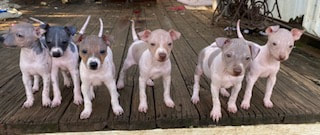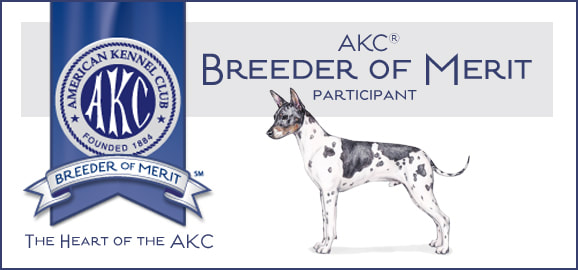Bellridge American Hairless Terriers
For more pictures of our dogs : Albums By Kari Jepson - ImageEvent
About American Hairless Terrier: The American Hairless Terrier is an energetic, alert dog whose curiosity and intelligence make him easy to train. The ancestors of this breed were bred to hunt. The lack of coat makes the hairless variety unsuited for hunting, but both varieties still have a strong hunting instinct and the coated dogs are fearless, tenacious hunters with seemingly unlimited energy.
The American Hairless Terrier is an exceptionally friendly companion, getting along well with children, other dogs, and even cats. American Hairless Terriers enjoy human companionship immensely and will enthusiastically share any activity with their owners. The hairless dogs require protection from the sun and winter cold weather. American Hairless Terriers should not be sparred during conformation judging.
We raise, show, hunt, and perform with our Rat Terriers and American American Hairless Terriers! We have a large farm in which our dogs help with vermin control, but first and foremost, they are our pets and live in our home.
History: The first American Hairless Terrier, a female named Josephine, was born in 1972, part of a litter of purebred, coated Rat Terriers. The breeder, Edwin Scott, began to develop the breed from Josephine's descendants. Although he never used any dogs but Rat Terriers in his breeding program, it was always Scott's intention for the hairless dogs to be a separate breed. However, in 1999, when United Kennel Club recognized the Rat Terrier, Scott and his fellow breeders agreed to allow the hairless dogs to enter the UKC registry as Rat Terriers, hairless variety. Upon separation, all of the hairless Rat Terriers and all of their coated descendants, products of careful breeding to the finest coated Rat Terriers, were given the name originally chosen for the breed by Edwin Scott: American Hairless Terrier. While it may seem contradictory to have coated dogs in a hairless breed, it will be necessary for the foreseeable future to continue to include some Rat Terrier crosses until there are sufficient hairless dogs to maintain a separate and healthy gene pool. The American Hairless Terrier was recognized by the United Kennel Club on January 1, 2004.
The American Hairless Terrier is an exceptionally friendly companion, getting along well with children, other dogs, and even cats. American Hairless Terriers enjoy human companionship immensely and will enthusiastically share any activity with their owners. The hairless dogs require protection from the sun and winter cold weather. American Hairless Terriers should not be sparred during conformation judging.
We raise, show, hunt, and perform with our Rat Terriers and American American Hairless Terriers! We have a large farm in which our dogs help with vermin control, but first and foremost, they are our pets and live in our home.
History: The first American Hairless Terrier, a female named Josephine, was born in 1972, part of a litter of purebred, coated Rat Terriers. The breeder, Edwin Scott, began to develop the breed from Josephine's descendants. Although he never used any dogs but Rat Terriers in his breeding program, it was always Scott's intention for the hairless dogs to be a separate breed. However, in 1999, when United Kennel Club recognized the Rat Terrier, Scott and his fellow breeders agreed to allow the hairless dogs to enter the UKC registry as Rat Terriers, hairless variety. Upon separation, all of the hairless Rat Terriers and all of their coated descendants, products of careful breeding to the finest coated Rat Terriers, were given the name originally chosen for the breed by Edwin Scott: American Hairless Terrier. While it may seem contradictory to have coated dogs in a hairless breed, it will be necessary for the foreseeable future to continue to include some Rat Terrier crosses until there are sufficient hairless dogs to maintain a separate and healthy gene pool. The American Hairless Terrier was recognized by the United Kennel Club on January 1, 2004.
About our breeding program
I am currently on the Board of Directors for the American Hairless Terrier Club of America. I am currently retired from breeding puppies but will continue with a few dogs in the show arena.
Our current focus with our dogs is show conformation and occasional barn hunt.
We are only breeding American Hairless Terriers that have been health tested: - ://www.ofa.org/recommended-tests?breed=AHT These are the tests that are currently recommended by the parent clubs for AKC and UKC. This testing is fairly comprehensive, however there is other testing that can and will be done by the hairless breeding community if or when other health concerns arise. Overall, the American Hairless Terrier is a very healthy breed and we want to keep it that way. For instance, although we generally do not see hip dyplasia in our breed, doing an X-ray of the hips will show any deformity not only in the hip area such as legg-calf perthes, but also any spine deformities. We rarely see elbow dyplasia and this may be taken off of the recommended test in future. Patellas are always at risk to be loose in small breeds and we do see some patella luxation. This can be mild to severe depending on the case. Normally, a puppy that has nice tight knee caps at 8 weeks, will prove to have healthy knees thoughout their life but an injury or weakness in that area can present a problem later in life. Surgery may be recommended and normally is a successful in repairing luxated patella. All of our breeding dogs are tested yearly for healthy knees.
Hearts are checked at 8 weeks by our DVM for any murmurs or irregularities. This should also be done yearly for breeding dogs. We feel that recording our health data on https://www.ofa.org/ OFA
gives a timeless record for all to access.
Other testing that is very important are PLL and PRA-PRCD of the eyes. These are breed specific passed down from the Rat Terrier. Genetic lab panel will indicate if a dog is a carrier , clear, or at risk. Carriers have not been known to exhibit the disease in our breed. However, you do not want to breed at risk or carrier to another carrier.
Because of the hairlessness, these dogs have no barrier between them and the elements so it very important to protect their skin. There will be times that you will see an irritation. If the redness and/or bumps are localized, this is probably an environmental irritant, however if you see red welts on the body, this indicates some kind of allergic reaction. Sudden welts may indicate a vaccine reaction, insect bite, or ingestion of a highly allergic substance. I have produced a few dogs that have been sensitive to chicken in their food and a change in protein sources has helped that problem. Again, this is something that I do not want to breed.
We do see allergy issues occasionally. The puppies should be exposed to a variety of foods which seems to help with immunity.
We do not allow puppies to leave until 8 weeks of age. All our puppies are raised in our home and we rarely have more than 2 litters a year.
Puppies receive wormings at 4 weeks of age as recommended by our DVM.
As far as Vaccinations, we give what is recommended for our area of the country which is a 5-way shot for puppies. We give this at 7 weeks. Lepto is added for the second and third shot as recommended by our Vet. Shots should be spaced 3-4 weeks apart, with rabies at 6 mos.
Puppies will also be microchipped before they leave us.
Our current focus with our dogs is show conformation and occasional barn hunt.
We are only breeding American Hairless Terriers that have been health tested: - ://www.ofa.org/recommended-tests?breed=AHT These are the tests that are currently recommended by the parent clubs for AKC and UKC. This testing is fairly comprehensive, however there is other testing that can and will be done by the hairless breeding community if or when other health concerns arise. Overall, the American Hairless Terrier is a very healthy breed and we want to keep it that way. For instance, although we generally do not see hip dyplasia in our breed, doing an X-ray of the hips will show any deformity not only in the hip area such as legg-calf perthes, but also any spine deformities. We rarely see elbow dyplasia and this may be taken off of the recommended test in future. Patellas are always at risk to be loose in small breeds and we do see some patella luxation. This can be mild to severe depending on the case. Normally, a puppy that has nice tight knee caps at 8 weeks, will prove to have healthy knees thoughout their life but an injury or weakness in that area can present a problem later in life. Surgery may be recommended and normally is a successful in repairing luxated patella. All of our breeding dogs are tested yearly for healthy knees.
Hearts are checked at 8 weeks by our DVM for any murmurs or irregularities. This should also be done yearly for breeding dogs. We feel that recording our health data on https://www.ofa.org/ OFA
gives a timeless record for all to access.
Other testing that is very important are PLL and PRA-PRCD of the eyes. These are breed specific passed down from the Rat Terrier. Genetic lab panel will indicate if a dog is a carrier , clear, or at risk. Carriers have not been known to exhibit the disease in our breed. However, you do not want to breed at risk or carrier to another carrier.
Because of the hairlessness, these dogs have no barrier between them and the elements so it very important to protect their skin. There will be times that you will see an irritation. If the redness and/or bumps are localized, this is probably an environmental irritant, however if you see red welts on the body, this indicates some kind of allergic reaction. Sudden welts may indicate a vaccine reaction, insect bite, or ingestion of a highly allergic substance. I have produced a few dogs that have been sensitive to chicken in their food and a change in protein sources has helped that problem. Again, this is something that I do not want to breed.
We do see allergy issues occasionally. The puppies should be exposed to a variety of foods which seems to help with immunity.
We do not allow puppies to leave until 8 weeks of age. All our puppies are raised in our home and we rarely have more than 2 litters a year.
Puppies receive wormings at 4 weeks of age as recommended by our DVM.
As far as Vaccinations, we give what is recommended for our area of the country which is a 5-way shot for puppies. We give this at 7 weeks. Lepto is added for the second and third shot as recommended by our Vet. Shots should be spaced 3-4 weeks apart, with rabies at 6 mos.
Puppies will also be microchipped before they leave us.


